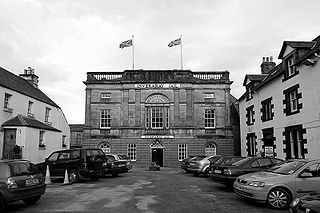
Inveraray Jail
Encyclopedia

Inveraray
Inveraray is a royal burgh in Argyll and Bute, Scotland. It is on the western shore of Loch Fyne, near its head, and on the A83 road. It is the traditional county town of Argyll and ancestral home to the Duke of Argyll.-Coat of arms:...
, Argyll and Bute
Argyll and Bute
Argyll and Bute is both one of 32 unitary council areas; and a Lieutenancy area in Scotland. The administrative centre for the council area is located in Lochgilphead.Argyll and Bute covers the second largest administrative area of any Scottish council...
, Scotland
Scotland
Scotland is a country that is part of the United Kingdom. Occupying the northern third of the island of Great Britain, it shares a border with England to the south and is bounded by the North Sea to the east, the Atlantic Ocean to the north and west, and the North Channel and Irish Sea to the...
is known as a living 19th-century prison
Prison
A prison is a place in which people are physically confined and, usually, deprived of a range of personal freedoms. Imprisonment or incarceration is a legal penalty that may be imposed by the state for the commission of a crime...
.
History
Designed by James Gillespie GrahamJames Gillespie Graham
James Gillespie Graham was a Scottish architect, born in Dunblane. He is most notable for his work in the Scottish baronial style, as at Ayton Castle, and he worked in the Gothic Revival style, in which he was heavily influenced by the work of Augustus Pugin...
(1776–1855) in 1813 after original plans by Robert Reid
Robert Reid (architect)
Robert Reid was the King's architect and surveyor for Scotland from 1827 to 1839. He is responsible for a number of public works particularly the façade of Parliament Square in Edinburgh, which houses the Court of Session....
in 1807. The original plans had called for a courthouse and three prisons, one for males, one for females and one for debtors. The ground obtained was sufficient for such an ambitious plan, but the finance was not and the Prison Commissioners had to be content with only one prison.
Both the courthouse and prisons opened in 1820. The courtroom, on the first floor, has a semicircle of large windows giving a magnificent view overlooking the prison yard and, beyond, across Loch Fyne
Loch Fyne
Loch Fyne is a sea loch on the west coast of Argyll and Bute, Scotland. It extends inland from the Sound of Bute, making it the longest of the sea lochs...
.
The two-storied prison has three-foot-thick walls of massive rough hewn red stone and originally contained cells on both floors, eight in total. A third of the ground floor was occupied by a day-room which was lit, like the cells, by narrow, unglazed windows.
The Prisons (Scotland) Act 1839 brought about many changes, including the separation of prisoners. A second prison was finally built on the spare ground, opening in the closing days of 1848. Designed by Thomas Brown
Thomas Brown
Thomas Brown may refer to:*Thomas Brunce , also known as Thomas Brown, English Bishop of Rochester & of Norwich*Thomas Brown , American husbandman, businessman, and land speculator...
of Edinburgh
Edinburgh
Edinburgh is the capital city of Scotland, the second largest city in Scotland, and the eighth most populous in the United Kingdom. The City of Edinburgh Council governs one of Scotland's 32 local government council areas. The council area includes urban Edinburgh and a rural area...
, the new prison consisted of twelve cells on three floors with an exercising gallery at the top. A pair of outdoor exercise yards were also built, separated from each other by a wall. Prisoners were not allowed to fraternize. The separate system
Separate system
The Separate system is a form of prison management based on the principle of keeping prisoners in solitary confinement. When first introduced in the early 19th century, the objective of such a prison or "penitentiary" was that of penance by the prisoners through silent reflection, as much as that...
was designed to give them time to reflect upon their sins.

Glasgow
Glasgow is the largest city in Scotland and third most populous in the United Kingdom. The city is situated on the River Clyde in the country's west central lowlands...
opened in 1882 and small local prisons in the West of Scotland began to close. Inveraray would be the last. On 20 July 1889 readers of the Argyllshire Herald were informed that "the prison of Inveraray will be closed on 31st August".
Despite changes to the prison system, the court was still sitting, continuing until 1954, with a little activity since then.
On several occasions the premises have come near to being abandoned, especially when it was necessary to spend money on repairs.
In the 1980s extensive restoration was undertaken by the Scottish Office
Scottish Office
The Scottish Office was a department of the United Kingdom Government from 1885 until 1999, exercising a wide range of government functions in relation to Scotland under the control of the Secretary of State for Scotland...
, but then all plans fell through and the building lay empty.
In May 1989, Inveraray Jail was reopened as a privately owned tourist attraction
Tourist attraction
A tourist attraction is a place of interest where tourists visit, typically for its inherent or exhibited cultural value, historical significance, natural or built beauty, or amusement opportunities....
, re-enacting the trial
Trial
A trial is, in the most general sense, a test, usually a test to see whether something does or does not meet a given standard.It may refer to:*Trial , the presentation of information in a formal setting, usually a court...
s and the life of the inmates of the 19th century.

